The Downstream Supply Chain for Electricity Generated from Renewables in Egypt: A Dynamic Analysis
Abstract
1. Introduction
2. Study Overview and Background Information
2.1. Renewable Energy Supply Chain
- The environmental impacts could be represented by many sub-factors [24], for example:
- Land requirement that correlates with the energy produced per unit of land.
- Greenhouse gas (GHG) emissions negatively impact public health and the environmental ecosystem.
- Sustainability refers to meeting contemporary requirements while safeguarding the capacity of future generations to achieve their goals [25].
- 2.
- Different governmental policies have been adopted across countries, especially in developing countries, as support instruments to deploy the RE in the field of electricity generation. Some countries within the European Union are using only one policy; however, others apply a combination of support policies to sustain renewable electricity [4], such as:
- Feed-in-tariffs (FiT) policy represents the money paid by the government to electricity suppliers for each unit of electricity produced in the network [26].
- Tax reductions or subsidies can assist investors in lowering their initial investment costs for RE systems.
- Renewable portfolio standards represent a progressive regulatory framework that delineates a specific proportion of electrical consumption or generation to be derived from renewable energy sources.
- 3.
- Also, social impact variables vary considerably [24], including the following:
- Local employment factor by measuring the direct and indirect employment related to RE projects that includes manufacturing, construction, operation and maintenance, project planning and management, consultancy, supply chain, and other services such as research and development (R&D), banking planning and management, and energy trading and distribution [27].
- Secure energy supply by ensuring consistent availability of sufficient energy supplies through the exploitation of local RE sources.
- Price stability of electricity by developing indigenous RE might eliminate price fluctuations.
- 4.
- Finally, the substitution effects include [4]:
- Electricity demanded from non-renewable sources refers to the energy volume consumed from fossil resources, which can impact the demand dynamics within the electricity market.
- Optimal price levels by adopting the RE may assist in preserving economically viable energy prices for end users.
- Economic shifts that change the budget invested in other power projects to be directed to RE technology to generate electricity, along with the financial profitability of acquiring such sources.
2.2. Energy Supply Systems Dimensions
3. Research Methods and Tools
4. Analysis and Results
4.1. Cross-Sectional Survey Results
4.1.1. Survey Design
4.1.2. Data Analysis
4.2. Questionnaire and Correlation Results
4.2.1. Distribution Variables
4.2.2. Demand Variables
5. Structuring a Conceptual Causal Loop Diagram
6. Managerial and Procedural Implications
6.1. Managerial Implications
- The survey and questionnaire results underline the value of joining diverse stakeholder views, particularly engineers, policymakers, and logistics specialists, into distribution planning to enhance adoption rates and strengthen policy legitimacy.
- The causal loop modeling developed in this study provides a valuable framework for evaluating future scenarios through the construction of stock and flow models before implementation, thereby reducing investment risks and improving strategic alignment with national energy goals.
- Managers should adopt a system dynamics modeling when planning energy distribution, considering the interdependence between technical, economic, environmental, and social dimensions, which ensures balanced trade-offs between efficiency, sustainability, and social acceptance.
6.2. Policy and Procedural Implications
- Energy planning procedures, especially the renewables, should integrate technical efficiency, economic viability, environmental impact, and social context as core evaluation criteria, ensuring that renewable energy distribution strategies address all key dimensions identified in this study.
- Institutions should combine causal loops and stock and flow modeling, as demonstrated in this study, into the policy design process to capture feedback loops, delays, and non-linear relationships in the renewable electricity supply chain.
- Planning procedures should track critical downstream supply chain metrics, such as distribution efficiency, demand satisfaction, and public acceptance, which were identified in the model as significant determinants of system performance.
7. Conclusions and Future Scopes
Author Contributions
Funding
Institutional Review Board Statement
Informed Consent Statement
Data Availability Statement
Acknowledgments
Conflicts of Interest
Abbreviations
| CLD | Causal Loop Diagram |
| CVI | Content Validity Index |
| FiT | Feed-in-tariffs |
| GHG | Greenhouse Gas |
| R&D | Research and Development |
| RE | Renewable Energy |
| RESC | Renewable Energy Supply Chain |
| SC | Supply Chain |
| SCM | Supply Chain Management |
Appendix A
Appendix A.1. Survey Validation Processes
Appendix A.1.1. Validation Questionnaire Template
| Please Indicate to What Extent You Agree with the Given Statement. | Comments | ||||
|---|---|---|---|---|---|
| Survey’s Sections | Your Assessment (Kindly Check the Column Which Is Appropriate for Each Item) | ||||
| Relevance and Clarity | |||||
| Not Relevant and Clear | Somewhat Relevant and Clear | Quite Relevant and Clear | Highly Relevant and Clear | ||
| 1 | 2 | 3 | 4 | ||
| Section 1 (Energy Supply System Indicators) | |||||
| 1. Technical | |||||
| 2. Economic | |||||
| 3. Environmental | |||||
| 4. Social | |||||
| Section 2 (Downstream Supply Chain Variables) | |||||
| 1. Distribution | |||||
| 2. Demand | |||||
Appendix A.1.2. CVI Application
Appendix A.2. Rating Process
Appendix A.3. Item Evaluation
- Calculate the I-CVI using Equation (A1).
- Calculate the scale-level S-CVI using Equation (A2) that reflects the overall content validity of the scale. This score is calculated by averaging the I-CVIs for all individual items or by using an alternate method that considers the proportion of items rated as relevant.
- Calculate the universal agreement method (UA-CVI) using Equation (A3) by calculating the proportion of items that receive an I-CVI score of 0.78 or higher. It is an additional conservative measure, ensuring that only items rated as highly relevant by the majority of experts are maintained.
| Sectors | |||||||||
|---|---|---|---|---|---|---|---|---|---|
| Section 1 | E 1 | E 2 | E 3 | E 4 | E 5 | E 6 | Es in Agreement | I-CVI | UA |
| 1. Technical dimension | 4 | 3 | 4 | 3 | 4 | 4 | 6 | 1 | 1 |
| 2. Economic dimension | 4 | 4 | 3 | 4 | 3 | 4 | 6 | 1 | 1 |
| 3. Environmental dimension | 4 | 3 | 4 | 4 | 2 | 3 | 5 | 0.83 | 0 |
| 4. Social dimension | 3 | 3 | 4 | 4 | 4 | 4 | 6 | 1 | 1 |
| Section 2: | E 1 | E 2 | E 3 | E 4 | E 5 | E 6 | Es in agreement | I-CVI | UA |
| 1. Distribution | 2 | 4 | 3 | 4 | 4 | 3 | 5 | 0.83 | 0 |
| 2. Demand | 4 | 4 | 3 | 4 | 3 | 3 | 6 | 1 | 1 |
| UA-CVI | 4/6 = 0.66 | ||||||||
| Proportion relevance | 0.83 | 1 | 1 | 1 | 0.83 | 1 | S-CVI (Ave) | 5.66/6 = 0.943 | |
| Total number of items = 6 (6 questions from 2 sections) | |||||||||
Appendix B
Appendix B.1. Survey’s Sample Size
Appendix B.2. Estimate Response Rate
References
- Aliyu, A.K.; Modu, B.; Tan, C.W. A Review of Renewable Energy Development in Africa: A Focus in South Africa, Egypt and Nigeria. Renew. Sustain. Energy Rev. 2018, 81, 2502–2518. [Google Scholar] [CrossRef]
- Mangla, S.K.; Luthra, S.; Jakhar, S.; Gandhi, S.; Muduli, K.; Kumar, A. A Step to Clean Energy-Sustainability in Energy System Management in an Emerging Economy Context. J. Clean. Prod. 2020, 242, 118462. [Google Scholar] [CrossRef]
- Mastrocinque, E.; Ramírez, F.J.; Honrubia-Escribano, A.; Pham, D. An AHP-based Multi-criteria Model for Sustainable Supply Chain Development in the Renewable Energy Sector. Expert Syst. Appl. 2020, 150, 113321. [Google Scholar] [CrossRef]
- Jelti, F.; Allouhi, A.; Büker, M.S.; Saadani, R.; Jamil, A. Renewable Power Generation: A Supply Chain Perspective. Sustainability 2021, 13, 1271. [Google Scholar] [CrossRef]
- Fashina, A.; Mundu, M.; Akiyode, O.; Abdullah, L.; Sanni, D.; Ounyesiga, L. The Drivers and Barriers of Renewable Energy Applications and Development in Uganda: A Review. Clean Technol. 2018, 1, 9–39. [Google Scholar] [CrossRef]
- Asante, D.; He, Z.; Adjei, N.O.; Asante, B. Exploring the Barriers to Renewable Energy Adoption Utilising MULTIMOORA-EDAS Method. Energy Policy 2020, 142, 111479. [Google Scholar] [CrossRef]
- RP, P.; Abdul Baseer, M.; Awan, A.B.; Zubair, M. Performance Analysis and Optimization of a Parabolic trough Solar Power Plant in the Middle East Region. Energies 2018, 11, 741. [Google Scholar] [CrossRef]
- Azevedo, S.G.; Santos, M.; Antón, J.R. Supply Chain of Renewable Energy: A Bibliometric Review Approach. Biomass Bioenergy 2019, 126, 70–83. [Google Scholar] [CrossRef]
- Paul, A.; Shukla, N.; Paul, S.K.; Trianni, A. Sustainable Supply Chain Management and Multi-criteria Decision-making Methods: A Systematic Review. Sustainability 2021, 13, 7104. [Google Scholar] [CrossRef]
- Ramos-Hernández, R.; Sánchez-Ramírez, C.; Sandoval-Salas, F.; Manotas-Duque, D.F.; Rivera-Cadavid, L.; Pérez-Rodríguez, S.I. Systemic Approach for the Design of Renewable Energy Supply Chain Generated from Biomass. In Techniques, Tools and Methodologies Applied to Global Supply Chain Ecosystems; García-Alcaraz, J., Sánchez-Ramírez, C., Avelar-Sosa, L., Alor-Hernández, G., Eds.; Springer Nature: Cham, Switzerland, 2020; Volume 166, pp. 259–283. [Google Scholar]
- Sadeghi, J.; Haapala, K.R. Optimizing a Sustainable Logistics Problem in a Renewable Energy Network Using a Genetic Algorithm. Opsearch 2019, 56, 73–90. [Google Scholar] [CrossRef]
- Saqib, Z.A.; Zhang, Q. Impact of Sustainable Practices on Sustainable Performance: The Moderating Role of Supply Chain Visibility. J. Manuf. Technol. Manag. 2021, 32, 1421–1443. [Google Scholar] [CrossRef]
- Saqib, Z.A.; Xu, G.; Luo, Q. Green Manufacturing for a Green Environment from Manufacturing Sector in Guangdong Province: Mediating Role of Sustainable Operations and Operational Transparency. Appl. Sci. 2024, 14, 10637. [Google Scholar] [CrossRef]
- Jafarinejad, S.; Beckingham, L.E.; Kathe, M.; Henderson, K. The Renewable Energy (RE) Industry Workforce Needs: RE Simulation and Analysis Tools Teaching as an Effective Way to Enhance Undergraduate Engineering Students’ Learning. Sustainability 2021, 13, 11727. [Google Scholar] [CrossRef]
- Cucchiella, F.; D’Adamo, I. Issue on Supply Chain of Renewable Energy. Energy Convers. Manag. 2013, 76, 774–780. [Google Scholar] [CrossRef]
- Hassanin, I.; Knez, M. Managing Supply Chain Activities in the Field of Energy Production Focusing on Renewables. Sustainability 2022, 14, 7290. [Google Scholar] [CrossRef]
- Lam, H.L.; Varbanov, P.S.; Klemeš, J.J. Optimisation of Regional Energy Supply Chains Utilising Renewables: P-graph Approach. Comput. Chem. Eng. 2010, 34, 782–792. [Google Scholar] [CrossRef]
- Wee, H.-M.; Yang, W.-H.; Chou, C.-W.; Padilan, M.V. Renewable Energy Supply Chains, Performance, Application Barriers, and Strategies for Further Development. Renew. Sustain. Energy Rev. 2012, 16, 5451–5465. [Google Scholar] [CrossRef]
- Balaman, Ş.Y.; Selim, H. Sustainable Design of Renewable Energy Supply Chains Integrated with District Heating Systems: A Fuzzy Optimization Approach. J. Clean. Prod. 2016, 133, 863–885. [Google Scholar] [CrossRef]
- Jeong, J.S.; Ramírez-Gómez, Á. Optimizing the Location of a Biomass Plant with a Fuzzy-DEcision-MAking Trial and Evaluation Laboratory (F-DEMATEL) and Multi-criteria Spatial Decision Assessment for Renewable Energy Management and Long-term Sustainability. J. Clean. Prod. 2018, 182, 509–520. [Google Scholar] [CrossRef]
- Sahebi, I.G.; Mosayebi, A.; Masoomi, B.; Marandi, F. Modeling the Enablers for Blockchain Technology Adoption in Renewable Energy Supply Chain. Technol. Soc. 2022, 68, 101871. [Google Scholar] [CrossRef]
- Acuna, M.; Sessions, J.; Zamora, R.; Boston, K.; Brown, M.; Ghaffariyan, M.R. Methods to Manage and Optimize Forest Biomass Supply Chains: A Review. Curr. For. Rep. 2019, 5, 124–141. [Google Scholar] [CrossRef]
- Ricardo Saavedra M., M.; Fontes, C.H.d.O.; Freires, F.G.M. Sustainable and Renewable Energy Supply Chain: A System Dynamics Overview. Renew. Sustain. Energy Rev. 2018, 82, 247–259. [Google Scholar] [CrossRef]
- Shen, Y.-C.; Lin, G.T.; Li, K.-P.; Yuan, B.J. An Assessment of Exploiting Renewable Energy Sources with Concerns of Policy and Technology. Energy Policy 2010, 38, 4604–4616. [Google Scholar] [CrossRef]
- Mohamed, S.K.; Haddad, S.; Barakat, M. Does blockchain adoption engender environmental sustainability? The mediating role of customer integration. Bus. Process Manag. J. 2024, 30, 558–585. [Google Scholar] [CrossRef]
- Dong, Z.; Yu, X.; Chang, C.-T.; Zhou, D.; Sang, X. How Does Feed-in tariff and Renewable Portfolio Standard Evolve Synergistically? An Integrated Approach of Tripartite Evolutionary Game and System Dynamics. Renew. Energy 2022, 186, 864–877. [Google Scholar] [CrossRef]
- Simas, M.; Pacca, S. Assessing Employment in Renewable Energy Technologies: A Case Study for Wind Power in Brazil. Renew. Sustain. Energy Rev. 2014, 31, 83–90. [Google Scholar] [CrossRef]
- Şengül, Ü.; Eren, M.; Shiraz, S.E.; Gezder, V.; Şengül, A.B. Fuzzy TOPSIS Method for Ranking Renewable Energy Supply Systems in Turkey. Renew. Energy 2015, 75, 617–625. [Google Scholar] [CrossRef]
- Qian, X.; Shen, L.; Wang, Y.; Lin, J.; Jin, Z.; Ge, Y.-E.; Haddad, S.S.G. Stability Analysis of Maritime Logistics Alliance Based on Blockchain. Transp. Policy 2025, 163, 219–231. [Google Scholar] [CrossRef]
- Giordano, R.; Osann, A.; Henao, E.; López, M.L.; Piqueras, J.G.; Nikolaidis, N.P.; Lilli, M.; Coletta, V.R.; Pagano, A. Causal Loop Diagrams for Bridging the Gap Between Water-Energy-Food-Ecosystem Nexus Thinking and Nexus Doing: Evidence from Two Case Studies. J. Hydrol. 2025, 650, 132571. [Google Scholar] [CrossRef]
- Alvarado, M.; Garrett, J.; Fullam, J.; Lovell, R.; Guell, C.; Taylor, T.; Garside, R.; Zandersen, M.; Wheeler, B.W. Using Causal Loop Diagrams to Develop Evaluative Research Propositions: Opportunities and Challenges in Applications to Nature-based Solutions. Syst. Dyn. Rev. 2024, 40, e1756. [Google Scholar] [CrossRef]
- Rutherford-Hemming, T. Determining Content Validity and Reporting a Content Validity Index for Simulation Scenarios. Nurs. Educ. Perspect. 2015, 36, 389–393. [Google Scholar] [CrossRef] [PubMed]
- Almanasreh, E.; Moles, R.; Chen, T.F. Evaluation of Methods Used for Estimating Content Validity. Res. Soc. Adm. Pharm. 2019, 15, 214–221. [Google Scholar] [CrossRef]
- Schober, P.; Boer, C.; Schwarte, L.A. Correlation Coefficients: Appropriate Use and Interpretation. Anesth. Analg. 2018, 126, 1763–1768. [Google Scholar] [CrossRef]
- Hadd, A.; Rodgers, J.L. Understanding Correlation Matrices; Sage Publications: Thousand Oaks, CA, USA, 2020; Volume 186. [Google Scholar]
- Hair, J.F.; Black, W.C.; Babin, B.J.; Anderson, R.E. Multivariate Data Analysis, 8th ed.; Cengage Learning: Hampshire, UK, 2019. [Google Scholar]
- Bermudez-Edo, M.; Barnaghi, P.; Moessner, K. Analysing Real World Data Streams with Spatio-temporal Correlations: Entropy vs. Pearson Correlation. Autom. Constr. 2018, 88, 87–100. [Google Scholar] [CrossRef]
- Roos, M. Feedback, Circular Causality, and System Dynamics. In Principles of Complexity Economics: Concepts, Methods and Applications; Springer: Berlin/Heidelberg, Germany, 2024; pp. 253–338. [Google Scholar]
- Mohammadi, M.A.; Sayadi, A.R.; Khoshfarman, M.; Kashan, A.H. A systems dynamics simulation model of a steel supply chain-case study. Resour. Policy 2022, 77, 102690. [Google Scholar] [CrossRef]

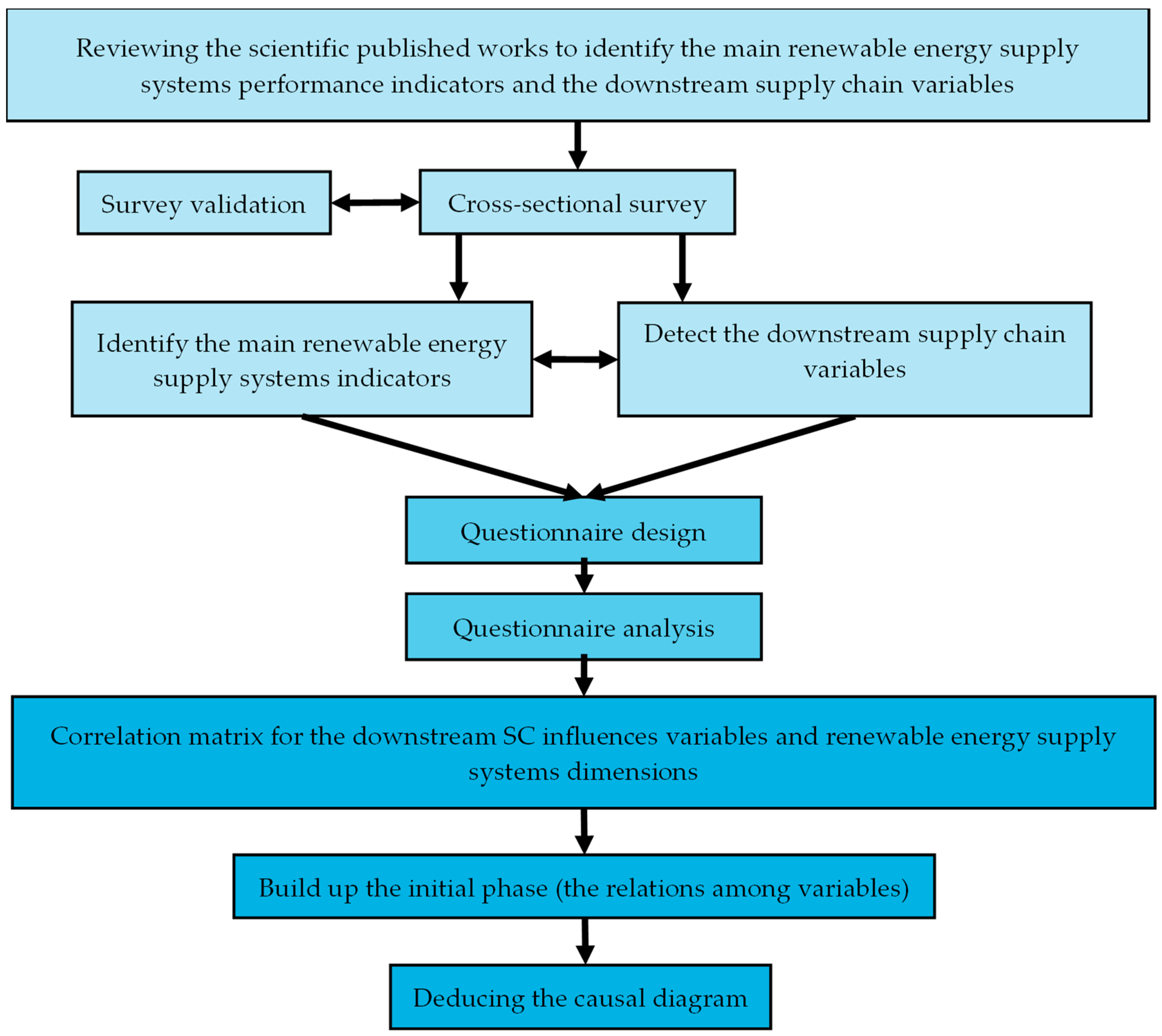

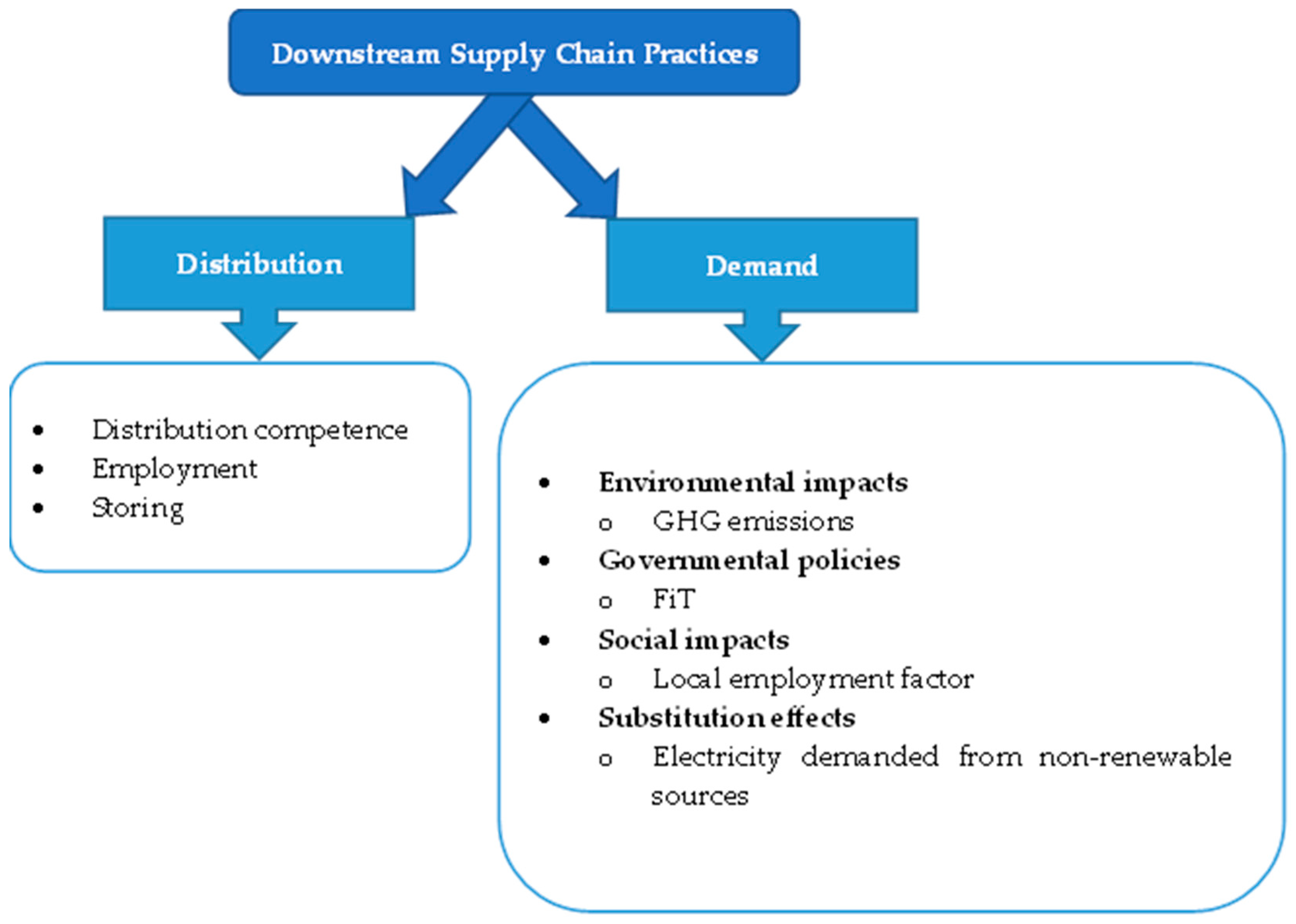
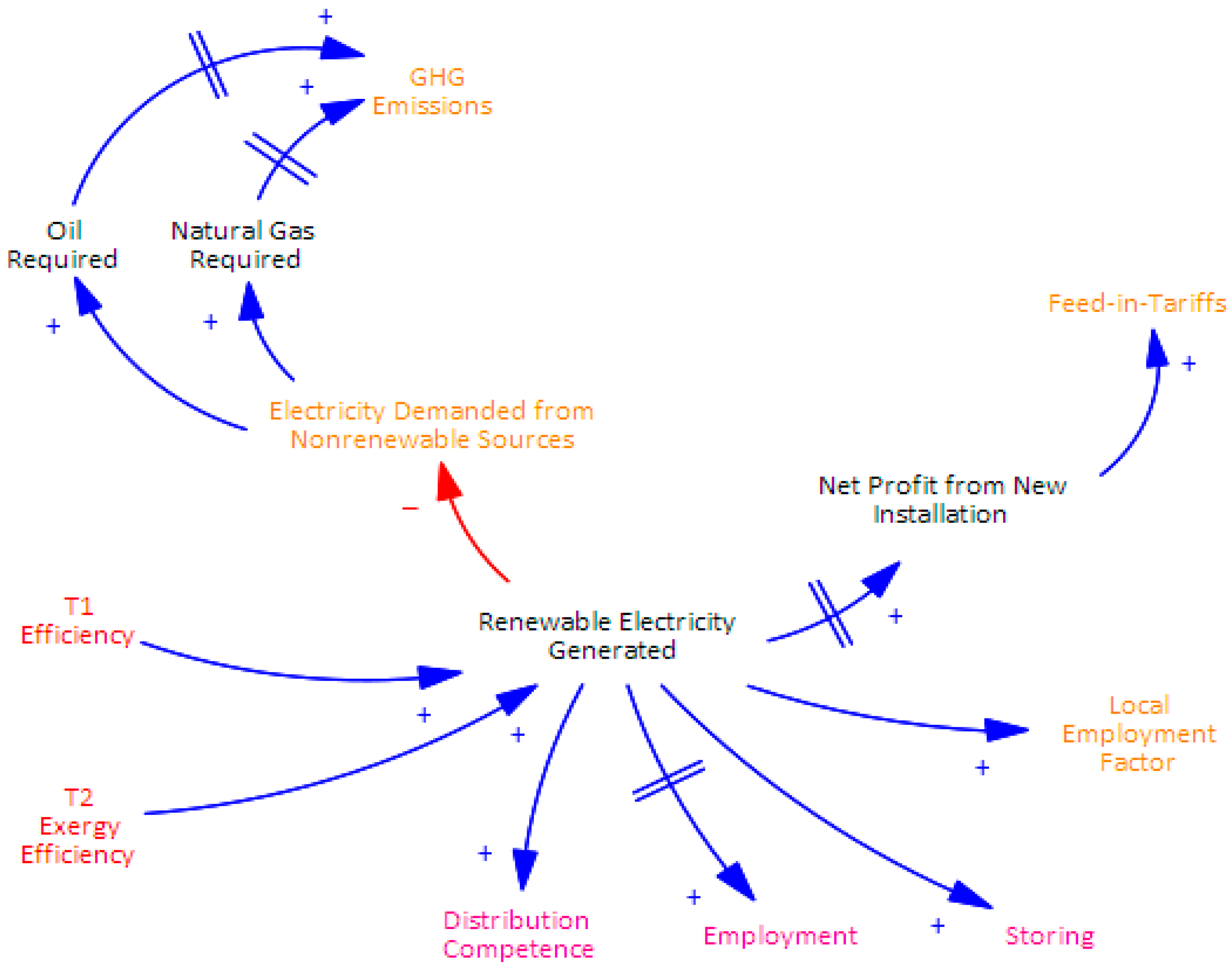
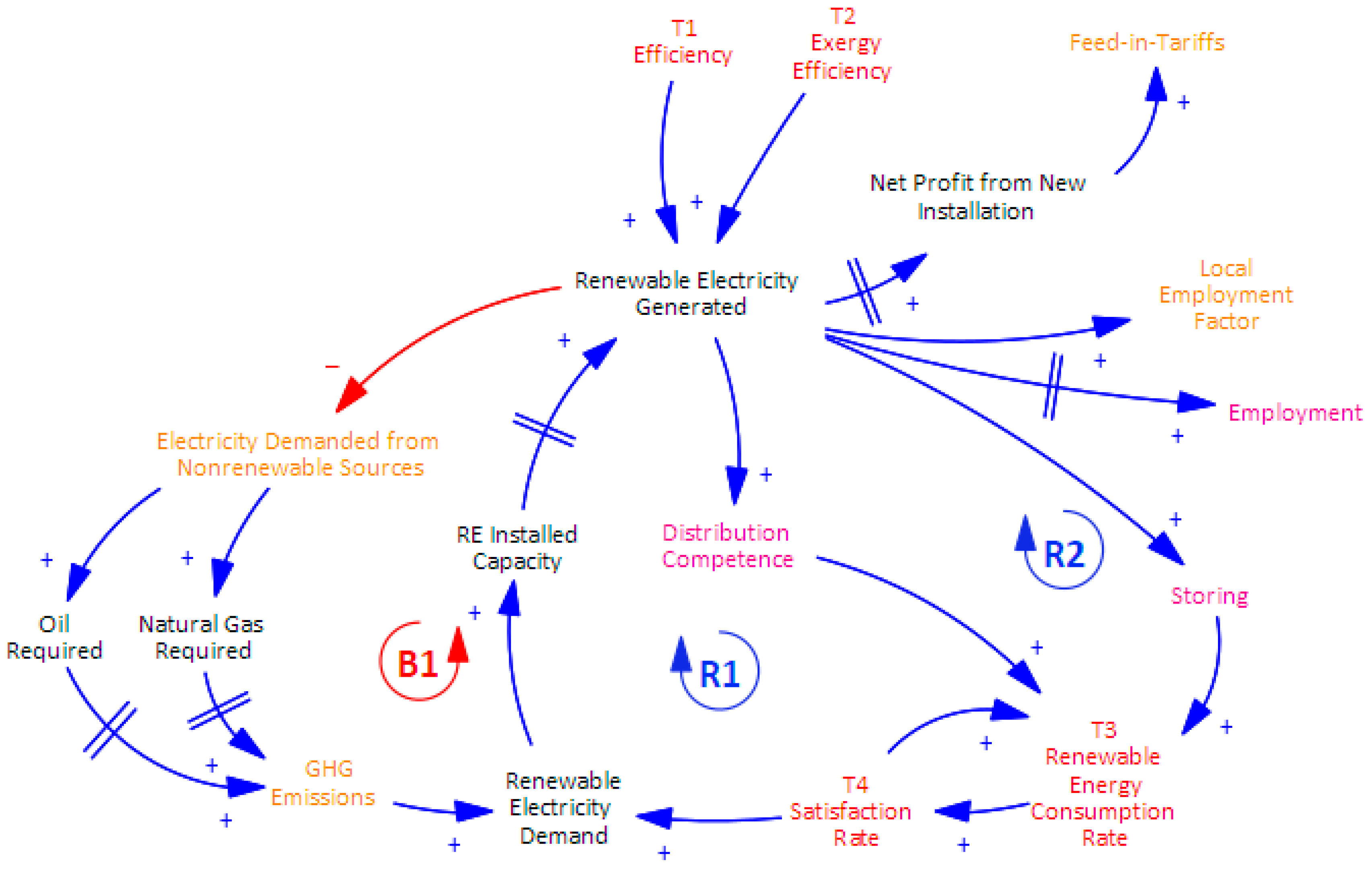
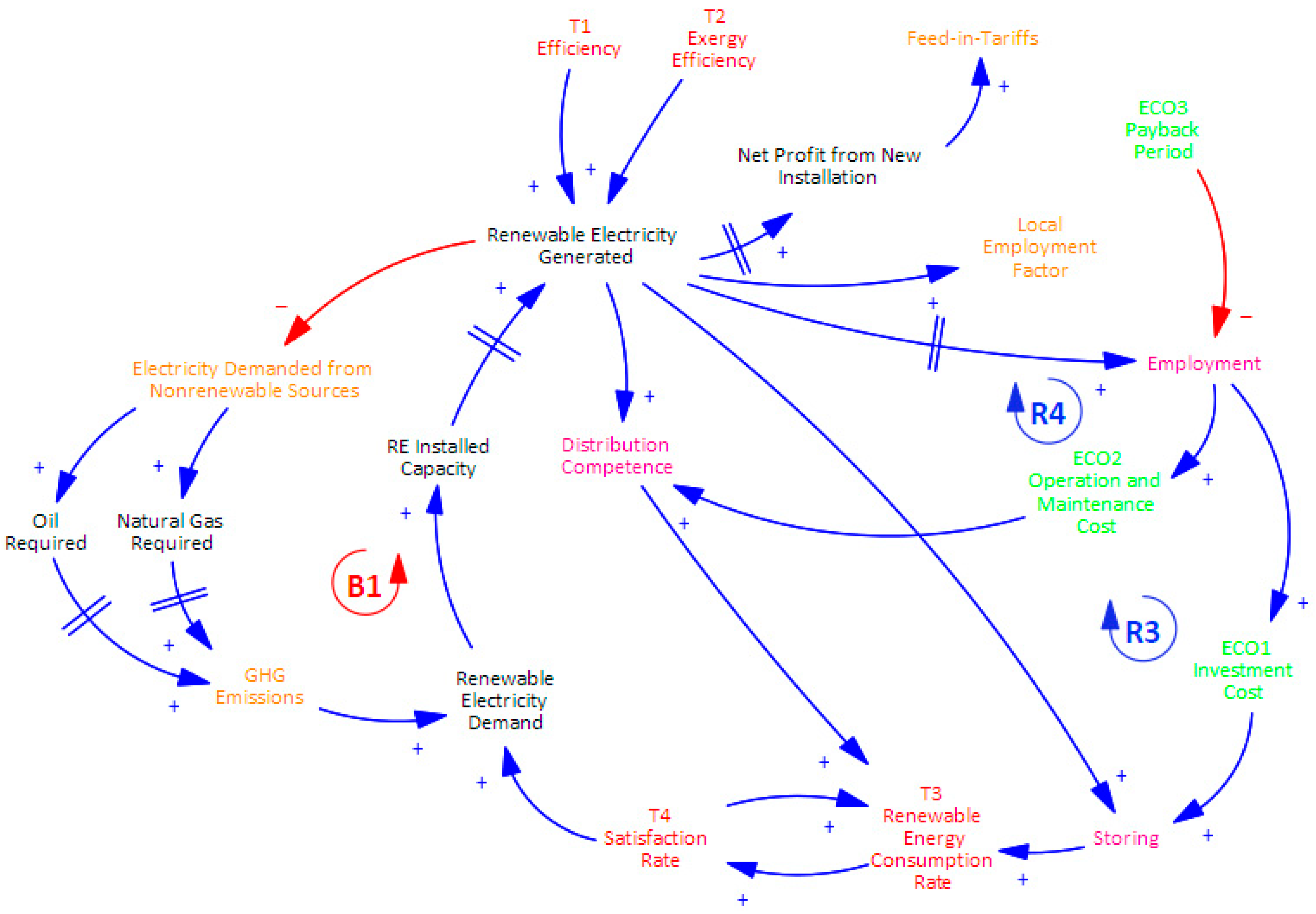
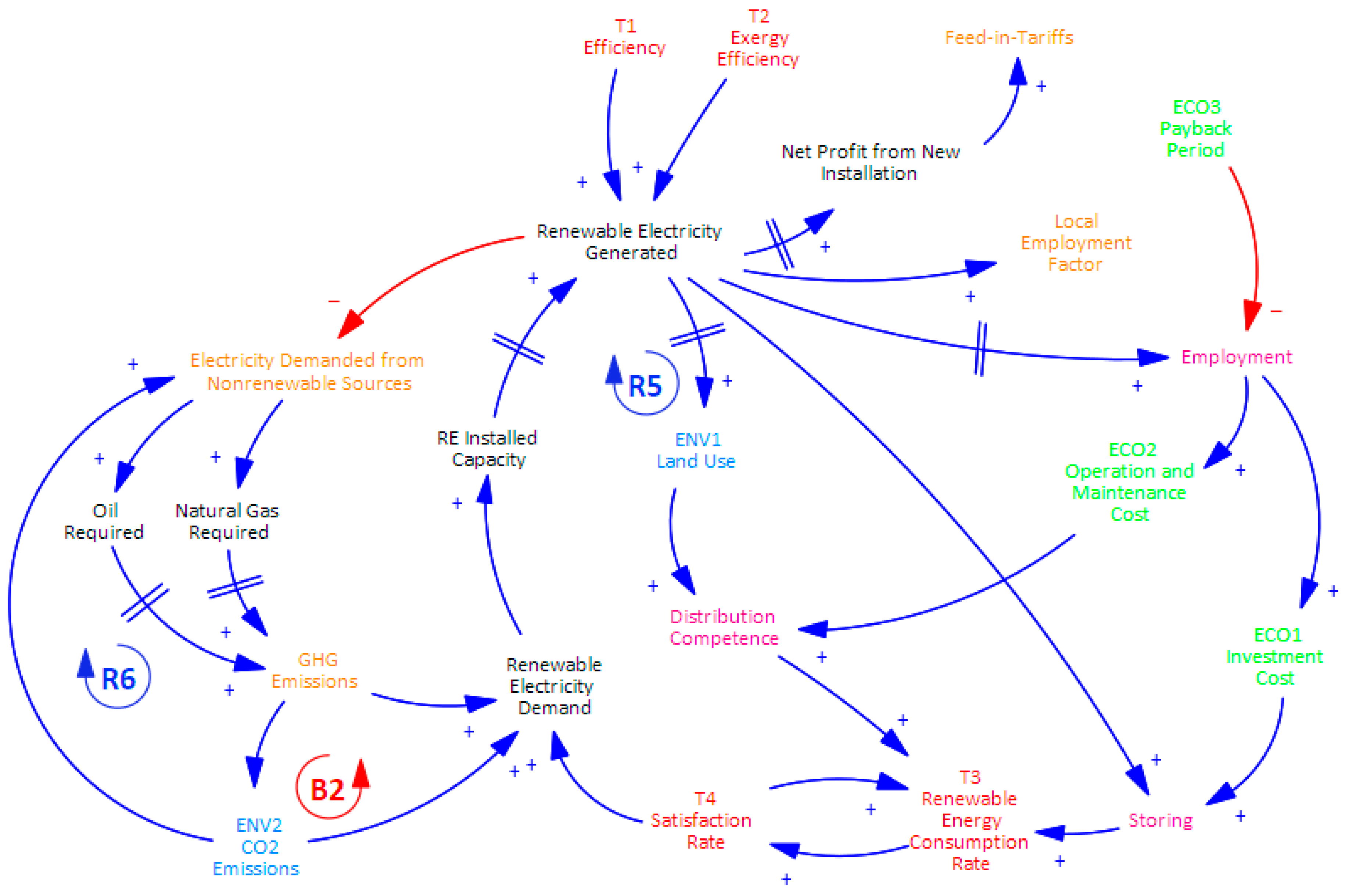
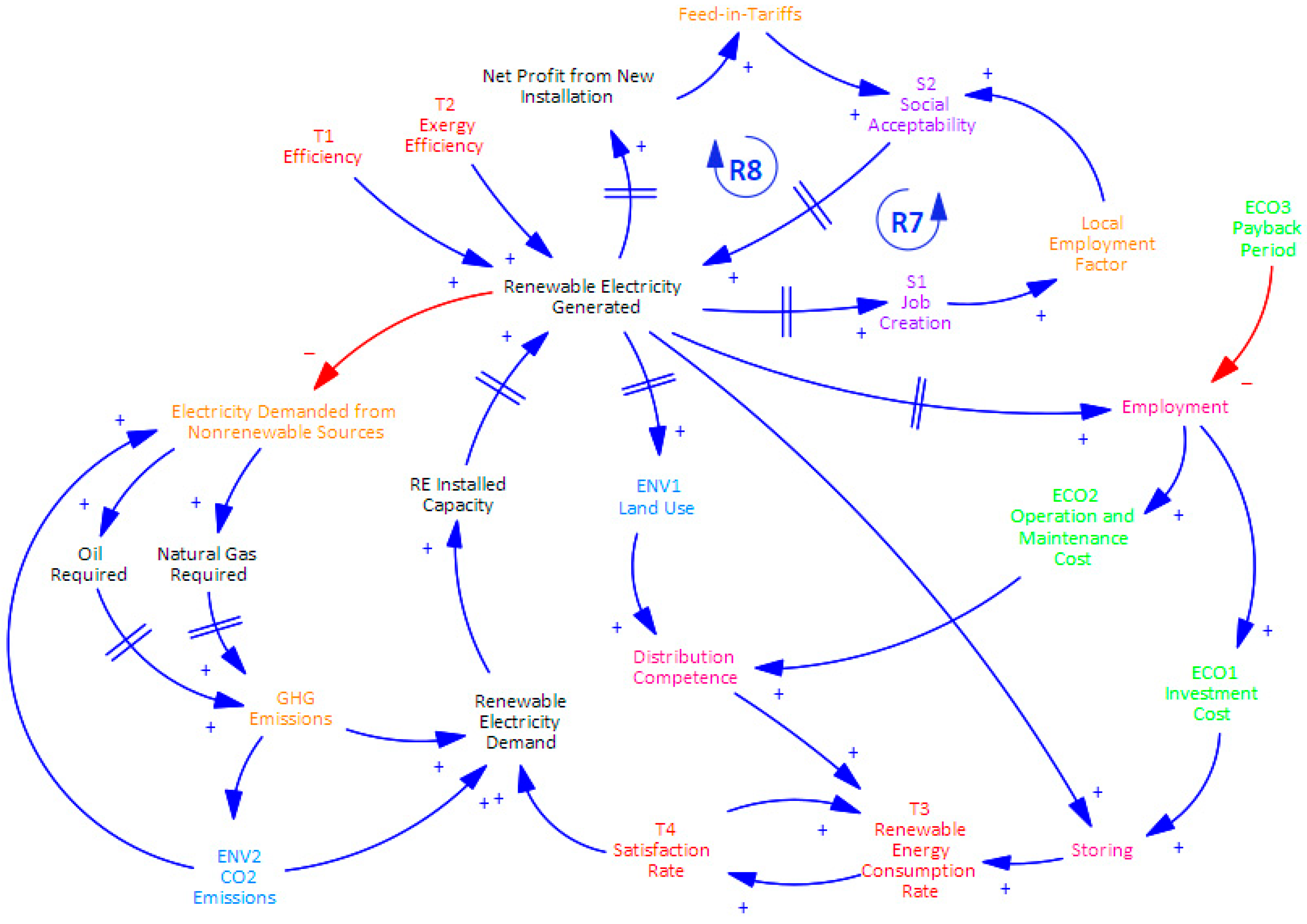
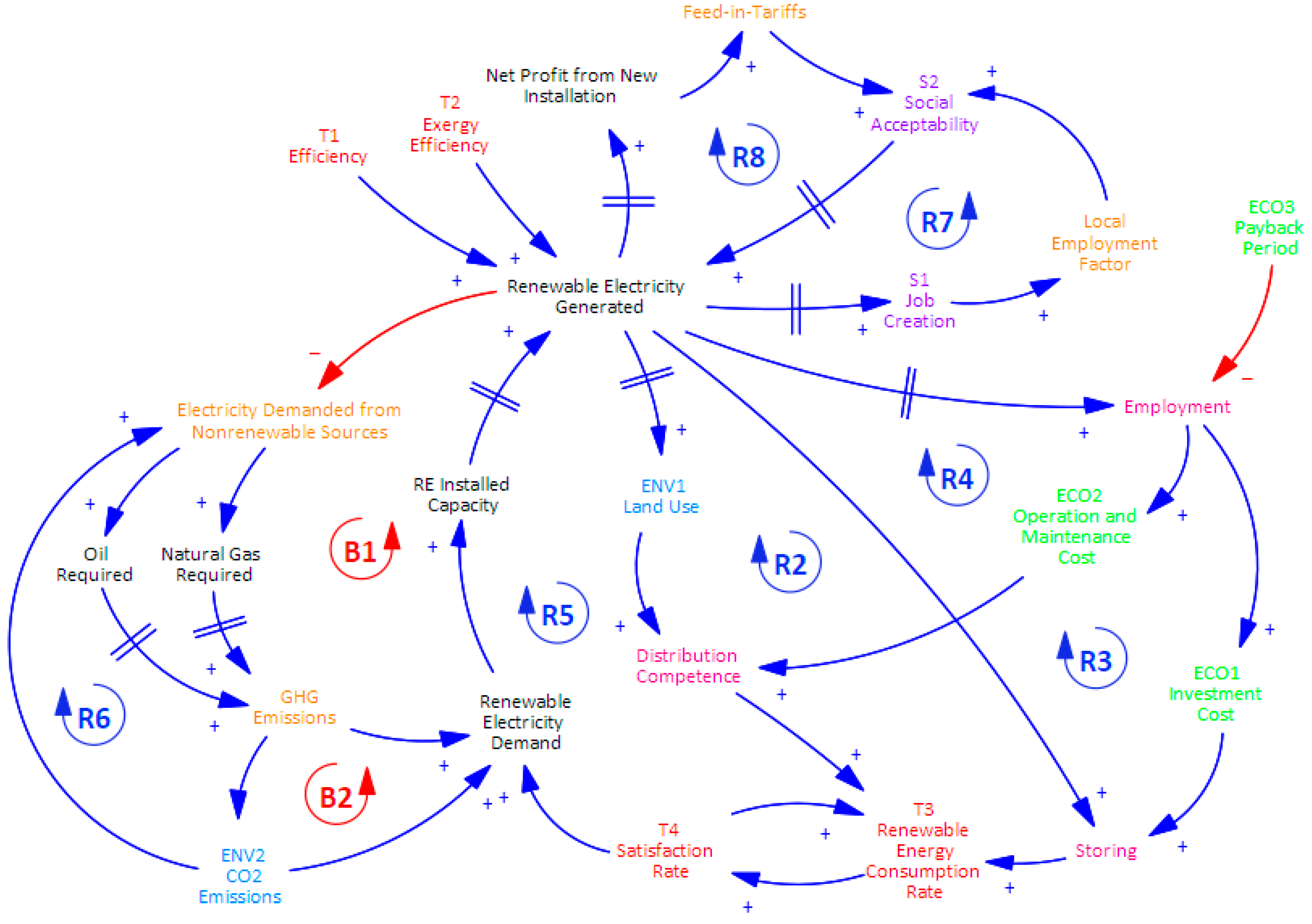
| Dimensions | Indicators | ||
|---|---|---|---|
| Technical |
|
|
|
| Economic |
|
|
|
| Environmental |
|
|
|
| Social |
|
|
|
| Categories | Sample Dissemination | Numbers | Percentage |
|---|---|---|---|
| Age | 26–30 years | 13 | 03.10% |
| 31–40 years | 197 | 46.90% | |
| 41–50 years | 180 | 42.90% | |
| 51–60 years | 30 | 07.10% | |
| Gender | Male | 370 | 88.10% |
| Female | 50 | 11.90% | |
| Education Degree | Bachelor’s degree | 336 | 80.00% |
| Master’s degree | 60 | 14.30% | |
| Ph.D. degree | 24 | 05.70% | |
| Employment Sector | Public sector | 298 | 71.00% |
| Private sector | 122 | 29.00% | |
| Professional Field | Academics | 13 | 03.10% |
| Supply chain specialists | 70 | 16.70% | |
| Logistics | 276 | 65.70% | |
| Energy experts | 61 | 14.50% |
| Indicators | Downstream SC Variables | |||||||
|---|---|---|---|---|---|---|---|---|
| Distribution | Demand | |||||||
| Di1 | Di2 | Di3 | De1 | De2 | De3 | De4 | ||
| Technical | T1 | 0.723 ** | 0.850 ** | 0.814 ** | −0.783 ** | 0.788 ** | 0.733 ** | −0.898 ** |
| T2 | 0.744 ** | 0.867 ** | 0.810 ** | −0.761 ** | 0.812 ** | 0.734 ** | −0.883 ** | |
| T3 | 0.614 ** | 0.761** | 0.671 ** | −0.667 ** | 0.734 ** | 0.767 ** | −0.811 ** | |
| T4 | 0.653 ** | 0.778 ** | 0.708 ** | −0.707 ** | 0.750 ** | 0.725 ** | −0.857 ** | |
| Economic | ECO1 | 0.373 ** | 0.454** | 0.473 ** | −0.426 ** | 0.423 ** | 0.448 ** | −0.580 ** |
| ECO2 | 0.523 ** | 0.590 ** | 0.446 ** | −0.228 ** | 0.586 ** | 0.584 ** | −0.386 ** | |
| ECO3 | −0.147 * | −0.262 ** | −0.404 ** | 0.366 ** | −0.171 ** | −0.456 ** | 0.466 ** | |
| Environmental | ENV1 | 0.328 ** | 0.506 ** | 0.484 ** | −0.393 ** | 0.423 ** | 0.598 ** | −0.498 ** |
| ENV2 | −0.227 ** | −0.299 ** | −0.288 ** | 0.438 ** | −0.277 ** | −0.222 ** | 0.537 ** | |
| Social | S1 | 0.567 ** | 0.746 ** | 0.642 ** | −0.503 ** | 0.651 ** | 0.846 ** | −0.620 ** |
| S2 | 0.683 ** | 0.827 ** | 0.811 ** | −0.783 ** | 0.753 ** | 0.720 ** | −0.892 ** | |
Disclaimer/Publisher’s Note: The statements, opinions and data contained in all publications are solely those of the individual author(s) and contributor(s) and not of MDPI and/or the editor(s). MDPI and/or the editor(s) disclaim responsibility for any injury to people or property resulting from any ideas, methods, instructions or products referred to in the content. |
© 2025 by the authors. Licensee MDPI, Basel, Switzerland. This article is an open access article distributed under the terms and conditions of the Creative Commons Attribution (CC BY) license (https://creativecommons.org/licenses/by/4.0/).
Share and Cite
Hassanin, I.; Muneer, T.; Knez, M. The Downstream Supply Chain for Electricity Generated from Renewables in Egypt: A Dynamic Analysis. Logistics 2025, 9, 150. https://doi.org/10.3390/logistics9040150
Hassanin I, Muneer T, Knez M. The Downstream Supply Chain for Electricity Generated from Renewables in Egypt: A Dynamic Analysis. Logistics. 2025; 9(4):150. https://doi.org/10.3390/logistics9040150
Chicago/Turabian StyleHassanin, Islam, Tariq Muneer, and Matjaz Knez. 2025. "The Downstream Supply Chain for Electricity Generated from Renewables in Egypt: A Dynamic Analysis" Logistics 9, no. 4: 150. https://doi.org/10.3390/logistics9040150
APA StyleHassanin, I., Muneer, T., & Knez, M. (2025). The Downstream Supply Chain for Electricity Generated from Renewables in Egypt: A Dynamic Analysis. Logistics, 9(4), 150. https://doi.org/10.3390/logistics9040150








